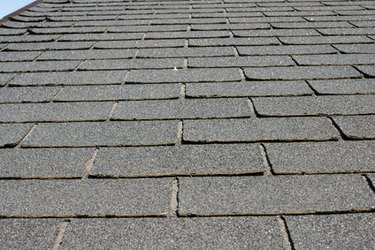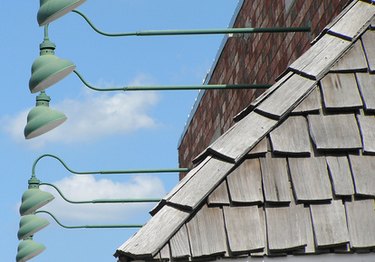
High winds are a major source of roof damage. According to a study of hurricane Hugo by Billy Manning and Gary Nichols, roofing material failure was the most widespread type of damage from that storm. High winds can lift roofing material away or damage it with debris blown from elsewhere. The most common roofing materials for pitched roofs are asphalt or composition shingles, metal, slate, wood shingles and tile. Each has different wind-resistance characteristics.
Asphalt Shingles
Video of the Day
Asphalt shingles are the most common type of residential roofing in the United States, used in 90 percent of U.S. houses. The cost per year of service for asphalt shingles is lower than other type of roofing. These shingles are also fire resistant and available in many different colors and several different styles. Standard asphalt shingles are certified to handle wind speeds from 60 to 80 miles per hour. Premium-priced, laminated shingles can be certified for wind speeds of up to 110 miles per hour.
Video of the Day
Metal
Metal roofing is more expensive than asphalt, but it offers better wind protection, lower maintenance and longer life. Standing-seam metal roofing is made of metal sheets folded or crimped together at the edges, and the metal shingles on metal shingle roofs interlock with each other. These strong connections between elements add to metal roofing's resistance to wind damage. Metal is also less likely to be damaged by wind-blown debris than other types of roofing.
Wood Shingles

Wood shingles are more expensive to purchase, install and maintain than asphalt shingles, and they are less fire-resistant. However, if properly installed, they are not any more susceptible to wind damage than are asphalt shingles.
Slate
Slate roofs are durable, heavy and resistant to wind damage. However, slate roofs are more expensive than other types of roofs, and shipping the heavy slate increases the expense as the distance from where the slate is quarried increases.
Tile

Because of their weight, properly installed tile roofs resist direct wind damage very well, but they are susceptible to damage from wind-blown debris. Clay tiles in particular are easily broken by impact and can crack under the weight of a person walking on them. According to Federal Emergency Management Agency Technical Fact sheet number 21, when a tile is broken, its fragments can damage other tiles and cause a cascade of damage. Cement tiles are less fragile than clay tiles.